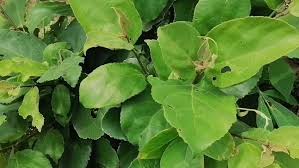[ninja_tables id=”44442″]
Ewe epin is a common leaf gotten from a shrub in bushes. These leaves are commonly used to wash soot and carbon dust stains from the back of kitchen wares due to their characteristic rough surface. Usually, almost every child who was raised before the 2000s has been sent to fetch this leaf. Apart from this, it has health-related uses, such as removing the crusty surface of some skin infections.
Sandpaper leaf, commonly called ewe epin, is a deciduous leaf that is gotten from the forest sandpaper plant. It commonly grows in the tropics and can grow as tall as 18 meters. Ewe epin – sandpaper leaf – is abundant in phytochemicals, and can therefore be used for some health issues, even though they are not commonly used for this purpose.
In this article, we will talk about the uses of ewe epin, with emphasis on the health benefits it poses and the phytochemicals it contains, responsible for each health benefit that can be derived from it. Also, we will consider the possible side effects and detriments of these phytochemicals to the human body.
Phytochemicals present in Ewe Epin (Sandpaper Leaf)
Although there are many important health benefits of ewe epin, the majority only use them for their rough surfaces, effective in cleaning kitchen wares. The health benefits of ewe epin stretches from its influence on the gut to its activity on the body lipids. However, these beneficial actions cannot be possible without the presence of some biochemicals in the plant.
Some of the phytochemicals responsible for the numerous health benefits attached to sandpaper leaves are highlighted below:
Alkaloids
These are phytochemicals that have carbon, nitrogen, and hydrogen as their constituent elements. Sometimes, they may contain phosphorus or bromine. They abound in plants are extensively used in the treatment of malaria in traditional medicine. Alkaloids are used by pharmaceutical companies to produce antiasthma, antibacterial, antimalarial, and analgesic drugs, among others.
They are majorly useful for protection purposes in plants that contain them, helping them to be undesirable to insects.
Cyanogenic
Cyanogenic glycosides [mfn]https://www.intechopen.com/chapters/52207[/mfn]are protectors of plants. They help to make plant parts undesirable for pests, such as insects. However, they also pose danger to humans when they consume the same plants, especially when they are consumed in abundance.
Cyanogenic glycosides are precursors for cyanides, popular for poisoning consumers and causing retarded growth or shut down of the central nervous system. However, the amount of cyanide in a plant can be reduced to safe levels by boiling, fermenting, or drying the plant parts to be consumed.
Tannins
Tannins work effectively, in association with alkaloids to provide anti-predatory protection for plants. They also aid in the development of plants. However, they used to be considered antinutritional, that is, unsuitable for consumption, even though they are present in many plant fruits that we eat.
Now, it has been discovered that tannins can be eaten only in low dosages. It helps to improve digestion when consumed in the right quantity.
Flavonoids
Flavonoids are abundant in many fruits and vegetables we eat, and there are different types of flavonoids. You can find them in teas and chocolates, and their major benefit to the human body is as antioxidants.
Saponins
Saponins are largely present in leguminous plants. This points to the richness of ewe epin in proteins and probably, fiber. They are also useful for cleaning as they form soap-like foams when in an aqueous solution, hence their use to clean kitchen wares.
These phytochemicals are present in the following volumes, according to research:
| Phytochemicals | Leaves | Stem |
| Alkaloids | 4.10 | 5.30 |
| Cyanogenic | 230.65 | 181.10 |
| Tannins | 4.10 | 3.25 |
| Flavonoids | 4.35 | 3.21 |
| Saponins | 0.13 | 0.17 |
Health Benefits and Uses of Ewe Epin
Treatment of Ulcers
Ulcers develop as a result of prolonged use of NSAIDs such as aspirin, causing the lining of the small intestine to develop sores that are irritated by the stomach acid. Individuals dealing with an ulcer cannot eat just any food, they need to be selective.
However, the stomachic and protective properties of ewe epin help to assuage the pain that comes with an ulcer. Affected individuals only have to chew and swallow the young leaves of the sandpaper plant.
Elimination of cancerous growth
When cell division goes out of control, making cells grow beyond their restricted area, cancer arises. In most cases, cancer can be controlled and prevented by consuming foods rich in antioxidants as they help to remove toxins from the cells, helping them function and grow normally.
Ewe epin, also called sandpaper leaf, contains flavonoids that possess antioxidant properties, helping the body remove oxidative waste from the cells.
Urinary Tract Infection Treatment
Urinary tract infections are most common among women. However, ewe epin can be used to treat various forms of urinary tract infection in both genders. Also, it helps to treat some sexually transmitted infections, such as gonorrhea.
The leaves are cooked with bananas and they are eaten to treat gonorrhea. The water from this is also drunk for the same purpose. This is because ewe epin has antifungal and antibacterial properties, gotten from the alkaloids it contains.
Used for healing lesions caused by Leprosy
Lesions and wounds on the body as a result of leprosy are usually treated using the leafy sap of ewe epin. The leaf is macerated so that its sap and pulp can be retrieved. The sap or leaf pulp is then applied to the lesion or wound surface.
It heals and dries up in a matter of days.
Works as an antihelminth
The anti-parasitic property of ewe epin – sandpaper leaf – helps to reduce the population of parasites, such as worms, when it is ingested. The alkaloids and tannins make the small intestine an inconducive environment for worms that attach themselves to the intestinal walls.
This makes it a good option for reducing the population of helminths in the stomach, making adequate nutrition attainable.
Used to treat dysentery and diarrhea
Sandpaper leaf has anti-inflammatory and antibacterial properties, which it uses to treat dysentery. It is also effective in treating diarrhea by putting a stop to the discrepancy that may exist in the gut. The leaves can be chewed and ingested or it can be macerated and the juice extracted and drunk to effect a stop to gastrointestinal issues.
Anti-hypertensive
In returning the heart to a normal state of pressure, ewe epin is one of the ingredients used in traditional medicine. It helps to reduce high blood pressure by exerting its alkaloids and flavonoids to return normalcy to heart muscles.
It also helps in managing hypertension in the long run by reducing bad cholesterol in the blood vessels, making blood flow less restricted, and making pumping action easier for the heart.
Treats skin infections
Skin infections that arise from fungal or bacterial causes are easily treated using ewe epin. In some cases, the crust formed on the surface of the lesion is removed using sandpaper leaf, to allow the topical medication to penetrate better.
However, ewe epin is also used to treat these infections. The leaf pulp or sap is applied to the wound surface to introduce its alkaloids and use its antibacterial property to heal the skin condition.
Related Article: 17 Plants and Fruits That Nourishes the Skin
Possible Side Effects of Ewe Epin
There is a high possibility for toxicity in the use of ewe epin. This is largely due to the presence of Cytogenic glycosides in high amounts. According to the table presented above, it is more abundant than other phytochemicals. However, it can be consumed, if properly processed, or consumed in minimal quantity.
It has been reported that cytogenic glycosides are detrimental to animals, but are widely fed to animals in many parts of Africa. The same phytochemical is found in cassava tubers and they are edible after processing.
However, on the consumption of high amounts of cyanide, a product of cytogenic glycoside, there is likely going to be:
- Slowed and difficulty in breathing
- Expulsion of excessive saliva from the mouth
- Heart attack
- Shut down of the central nervous system.
Conclusion
Ewe epin – sandpaper leaf is a common part of the tropical plant, Forest sandpaper fig. Its leaves are primarily used for its abrasiveness, to clean soot-stained kitchen wares. However, it also has health benefits that tend to be lost these days.
Its health benefits stem from the presence of many phytochemicals which help to treat wounds and lesions from leprosy and other skin conditions, treat diarrhea and dysentery, treat ulcers, and can be used as an antihelminth.





